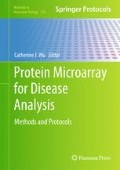Abstract
Protein microarrays are a high-throughput technology capable of generating large quantities of proteomics data. They can be used for general research or for clinical diagnostics. Bioinformatics and statistical analysis techniques are required for interpretation and reaching biologically relevant conclusions from raw data. We describe essential algorithms for processing protein microarray data, including spot-finding on slide images, Z score, and significance analysis of microarrays (SAM) calculations, as well as the concentration dependent analysis (CDA). We also describe available tools for protein microarray analysis, and provide a template for a step-by-step approach to performing an analysis centered on the CDA method. We conclude with a discussion of fundamental and practical issues and considerations.
Access this chapter
Tax calculation will be finalised at checkout
Purchases are for personal use only
References
Hartmann M, Roeraade J, Stoll D, Templin MF, Joos TO (2009) Protein microarrays for diagnostic assays. Anal Bioanal Chem 393:1407–1416
Wolf-Yadlin A, Sevecka M, MacBeath G (2009) Dissecting protein function and signaling using protein microarrays. Curr Opin Chem Biol 13:398–405
Coleman MA, Beernink PT, Camarero JA, Albala JS (2007) Applications of functional protein microarrays: identifying protein-protein interactions in an array format. Methods Mol Biol 385:121–130
Ehricht R, Adelhelm K, Monecke S, Huelseweh B (2009) Application of protein arraytubes to bacteria, toxin, and biological warfare agent detection. Methods Mol Biol 509:85–105
Michaud GA, Salcius M, Zhou F, Papov VV, Merkel J, Murtha M, Predki P, Schweitzer B (2006) Applications of protein arrays for small molecule drug discovery and characterization. Biotechnol Genet Eng Rev 22:197–211
Kerschgens J, Egener-Kuhn T, Mermod N (2009) Protein-binding microarrays: probing disease markers at the interface of proteomics and genomics. Trends Mol Med 15:352–358
Hall DA, Ptacek J, Snyder M (2007) Protein microarray technology. Mech Ageing Dev 128:161–167
Lubomirski M, D’Andrea MR, Belkowski SM, Cabrera J, Dixon JM, Amaratunga D (2007) A consolidated approach to analyzing data from high-throughput protein microarrays with an application to immune response profiling in humans. J Comput Biol 14:350–359
MacBeath G, Schreiber SL (2000) Printing proteins as microarrays for high-throughput function determination. Science 289:1760–1763
Brusic V, Marina O, Wu CJ, Reinherz EL (2007) Proteome informatics for cancer research: from molecules to clinic. Proteomics 7:976–991
Zhu X, Gerstein M, Snyder M (2006) ProCAT: a data analysis approach for protein microarrays. Genome Biol 7:R110
White AM, Daly DS, Varnum SM, Anderson KK, Bollinger N, Zangar RC (2006) ProMAT: protein microarray analysis tool. Bioinformatics 22:1278–1279
Marina O, Biernacki MA, Brusic V, Wu CJ (2008) A concentration-dependent analysis method for high density protein microarrays. J Proteome Res 7:2059–2068
Dennis G Jr, Sherman BT, Hosack DA, Yang J, Gao W, Lane HC, Lempicki RA (2003) DAVID: database for annotation, visualization, and integrated discovery. Genome Biol 4:P3
Reich M, Liefeld T, Gould J, Lerner J, Tamayo P, Mesirov JP (2006) GenePattern 2.0. Nat Genet 38:500–501
Hueber W, Kidd BA, Tomooka BH, Lee BJ, Bruce B, Fries JF, Sonderstrup G, Monach P, Drijfhout JW, van Venrooij WJ, Utz PJ, Genovese MC, Robinson WH (2005) Antigen microarray profiling of autoantibodies in rheumatoid arthritis. Arthritis Rheum 52:2645–2655
Biernacki MA, Marina O, Zhang W, Liu F, Bruns I, Cai A, Neuberg D, Canning CM, Alyea EP, Soiffer RJ, Brusic V, Ritz J, Wu CJ (2010) Antigen targets of remission-inducing immune therapy are expressed on CML progenitor cells. Cancer Res 70(3):906–915
Tusher VG, Tibshirani R, Chu G (2001) Significance analysis of microarrays applied to the ionizing radiation response. Proc Natl Acad Sci USA 98:5116–5121
D’Agostino DB, Belanger A, D’Agostino RB (1990) A suggestion for using powerful and informative tests of normality. Am Stat 44:316–321
Anderson TW, Linfeng Y (1996) Adequacy of asymptotic theory for goodness-of-fit criteria for spectral distributions. J Time Ser Anal 17:533–552
Shapiro SS (1990) How to test normality and other distributional assumptions, Revth edn. ASQC, Milwaukee, WI
Shapiro SS, Wilk MB (1965) An analysis of variance test for normality (complete samples). Biometrika 52:591–611
Schena M (2005) Protein microarrays. Jones and Bartlett, Sudbury, MA
Guyon I, Weston J, Barnhill S, Vapnik V (2002) Gene selection for cancer classification using support vector machines. Machine Learn 46:389–422
Acknowledgments
C.J.W. acknowledges support from the Department of Defense (W81XWH-07-1-0080), the Miles and Eleanor Shore Award, NCI (5R21CA115043-2), the Early Career Physician-Scientist Award of the Howard Hughes Medical Institute, and is a Damon-Runyon Clinical Investigator supported (in part) by the Damon-Runyon Cancer Research Foundation (CI-38-07). O.M. acknowledges support from a Medical Student Fellowship of the Howard Hughes Medical Institute.
Author information
Authors and Affiliations
Corresponding author
Editor information
Editors and Affiliations
Rights and permissions
Copyright information
© 2011 Springer Science+Business Media, LLC
About this protocol
Cite this protocol
DeLuca, D.S., Marina, O., Ray, S., Zhang, G.L., Wu, C.J., Brusic, V. (2011). Data Processing and Analysis for Protein Microarrays. In: Wu, C. (eds) Protein Microarray for Disease Analysis. Methods in Molecular Biology, vol 723. Humana Press. https://doi.org/10.1007/978-1-61779-043-0_21
Download citation
DOI: https://doi.org/10.1007/978-1-61779-043-0_21
Published:
Publisher Name: Humana Press
Print ISBN: 978-1-61779-042-3
Online ISBN: 978-1-61779-043-0
eBook Packages: Springer Protocols

